A true story of robotization, starting with one simple graphic
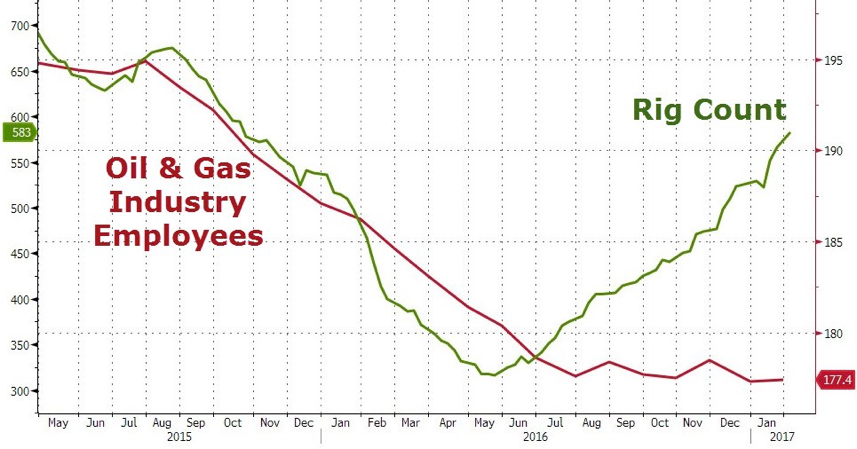
At the beginning of this year, I caught sight of a graph that reflects not only the extremely important history of robotization, but also the history of discussion of robotization itself. At the same time, here is shown the development forecast in the coming years of both the robotization itself and its discussion. This is a graph of the number of exploited drilling rigs in the United States (green line) and the number of workers employed in the oil industry (red line). This is an important piece of the mosaic that needs to be put together before it is too late.
Studying the chart, the first thing that catches your eye is the reduction in the number of oil rigs associated with a fall in oil prices, proportional to the number of workers employed in the oil industry. But when the number of drilling workers began to increase, the number of employed workers remained at about the same level . This observation in itself should be extremely interesting to all those who dispute the existence of technological unemployment. But from this chart you can learn something more important.
')
First, have you heard about automated oil drilling rigs, or is this news for you? They are called "Iron Pombur" (assistant driller). They automate the process of screwing and unscrewing drill pipes during their immersion or recovery from a well. Admire the National Oilwell Varco AR3200 - an automated iron driller assistant.

Thanks to automatic drilling, fewer people are now required to perform this once-dangerous and very labor-intensive operation. Automating rigs means increasing productivity while reducing the number of maintenance personnel. If earlier it required 20 people to maintain one oil rig, then soon 5 people would be enough . The use of new technologies in the drilling of oil wells means that out of 440,000 jobs, reduced during the global economic crisis, about 220,000 jobs will be lost forever .
Now look at the chart again and notice the speed of the fall. It took only TWO YEARS . Why so fast? The oil industry really does not need workers, so she got rid of them in the first place. In the oil industry it was possible to earn a lot of money, and when they flow into the pocket in an endless stream, there is no need to focus on production efficiency. Being thrifty and modest is not about them. However, everything changes when difficult times come. And present times have become a great challenge even for the oil industry. One of the factors behind the sharp drop in oil prices was rivalry with another type of technological progress - hydraulic fracturing technology.
Therefore, when it was necessary to increase efficiency, the oil industry primarily reduced the number of jobs and invested in drilling automation. In the summer of 2016, oil prices reached a minimum of $ 30 per barrel, after which they rose slightly to the level of $ 50 per barrel, where they stopped. This is half of the “usual” price of $ 100 per barrel, so oil companies had to double their efficiency. As a result, like the phoenix bird, the oil industry was "reborn from the ashes." Almost all previously conserved drilling rigs resumed their work, but not all workers returned to their jobs.
Sleep under the sound of the alarm clock
Technological unemployment has already become a fait accompli, but people continue to argue about its possible appearance in the future. This situation is very similar to the one that has evolved around climate change: disputes about it are still not abating, although we already see the manifestations of climate change every day. Robotization is real, people. Companies are actively investing in robotization, because it means an increase in production while reducing costs. It is good for business.
Wages, salaries and other types of remuneration - all this overhead costs that can be minimized by automating the production process.
But do not worry! "All the unemployed who have lost their jobs due to robotization will find a better job in other places where they pay even more." Well, generally speaking, this is not exactly what the history of robotization in the computer age that has been going on for the last 40 years shows. Yes, some highly skilled workers have moved to higher-paying jobs, but there are very few of them. Most people end up finding a new job that requires less skill, but less pay . That is, the labor market is steadily polarized.
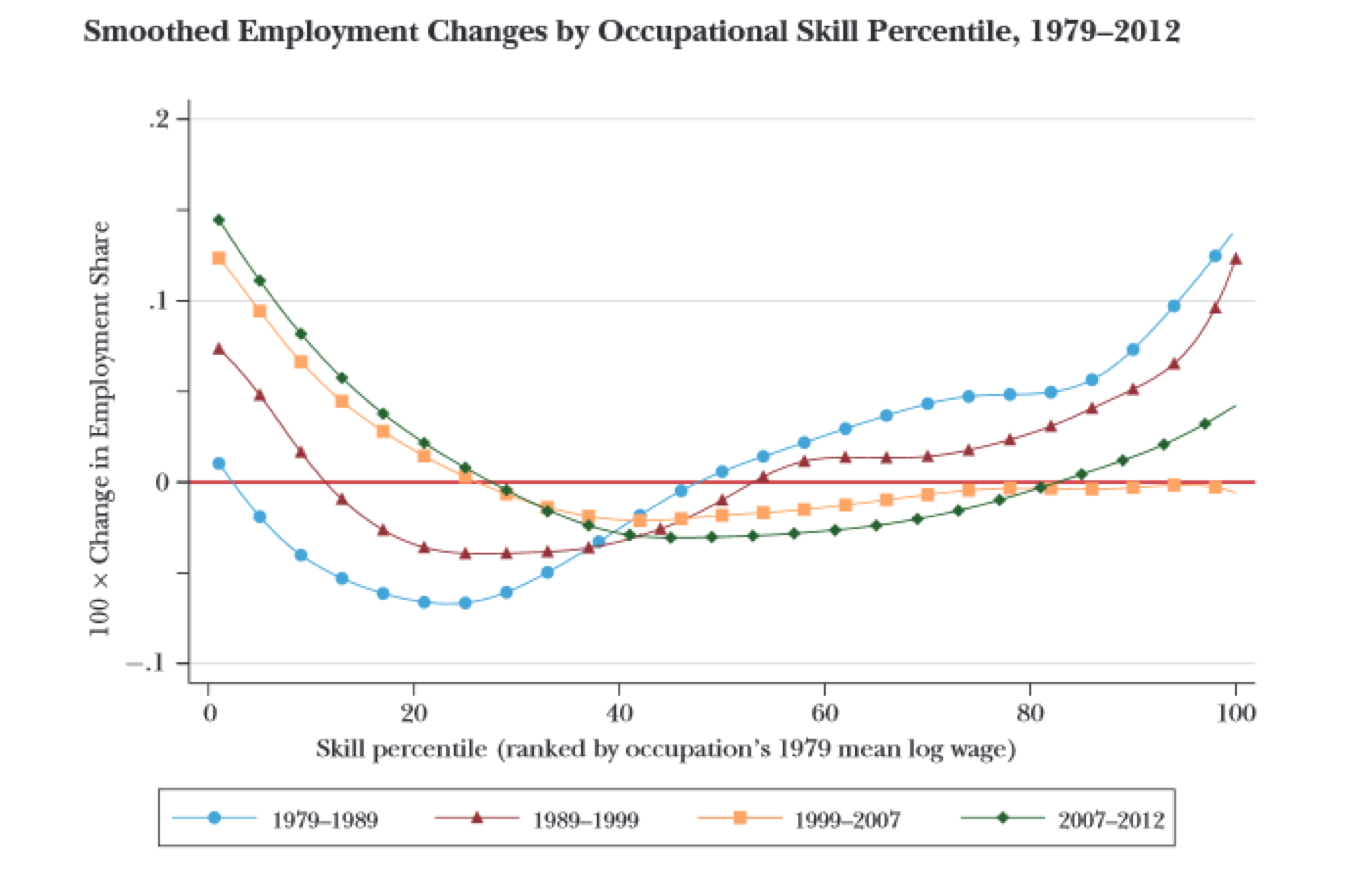
Decades after decades, workplaces for people with an average skill level are reduced in production workshops and offices, and laid-off workers find new, less qualified jobs. Those who have lost their jobs due to robotization need to live on something, so in the end they are content with what they can get. At the same time, there is growing competition for such jobs ( as long as the labor market remains chaotic ), and agreeing to lower wages, people take on any job that they are offered in a race against cars . It also reduces the attractiveness of automation investments. As an added bonus, workstations are more productive than most new jobs . Cheaper human labor and a growing number of low productivity jobs lead to a “paradoxical” slowdown in productivity growth . In short, the labor market for middle-skilled workers is disappearing. This is a reality that we have seen over the past decades.
In 2017, a study was conducted , the authors of which analyzed the effect of industrial robots only on jobs from 1993 to 2007. It turned out that each new robot replaces 5.6 workers, and each additional robot reduces the proportion of the total employed population by 0.34% by 1000 workers and reduces wages by 0.5% . Over this 14-year period, industrial robots have quadrupled, while at the same time the number of jobs has decreased in the range of 360,000 to 670,000. As the authors note: “ Interesting and, perhaps surprisingly, we have not found positive and compensating successes in solving the problem of employment in any field of activity or education ". In other words, lost jobs were not replaced by new jobs.
It is expected that the number of industrial robots will double by 2025, there will be 7 robots per 1000 workers ( in Toledo and Detroit, there are already 9 robots per 1000 workers ). Based on the results of Acemoglu and Restropo (Restropo) studies, it is possible to predict that by 2025 the number of jobs will decrease by 3.4 million , wage growth will decrease by 2.6%, and the share of working among the economically active population will decrease 1.76%. Please note - we are talking only about industrial robots, and not about all robots. We do not take into account software, and, of course, artificial intelligence. And the overall impact of all technologies will undoubtedly be higher.
Robotization happens right under the nose of each of us, but people are just beginning to talk about its potential dangers that we may face in the near future. For example, robotization can lead to a reduction in income for many people on the planet. In the US, it is believed that by the early 2030s there will be a reduction in all existing jobs . It's great that they finally started to discuss this problem, but most people are unaware that the robotization has already begun. And about half of those who know about this, it is awkward to believe that robotization should not cause concern. On the contrary, this should be a matter of serious concern.
History tour
The clearest statistics regarding robotization is the fact that almost the entire US adult population is aware of the loss of manufacturing jobs over the past thirty years. Pew Research conducted a survey among more than 4,000 US residents . As a result, it turned out that 81% of respondents are aware of this fact. However, few people know that with this, the total volume of production has increased. The US is now producing more than ever, and only 35% of the country's adult population is aware of this fact. Only 26% of Americans know both of these facts.

Only every fourth American knows that, thanks to technology in the United States, production has increased while reducing the number of employees. And the rest are blamed for the loss of jobs of immigrants or write off everything on the withdrawal of production abroad, although the latter is possible only with the improvement of technology. Because of the transfer abroad, we lost 13% of jobs in the manufacturing sector . This is problem. We will not be able to change anything if people do not know about the existence of a problem, or think that its very existence is a subject of discussion. One cannot agree with such decisions as guaranteed unconditional basic income paid as a dividend of productivity , if productivity growth is increasingly becoming the cause of job losses, and in discussions it is considered a future danger to our social system, rather than a direct and obvious threat.
Let's think about what happens when the next recession sets in? The fall in oil prices caused a recession in the oil industry, caused massive unemployment and spurred investment in robotization. What will happen when all industries respond to mass unemployment and investments in robotization? If we look at the recent history, each subsequent recession led to a permanent decline in the labor market. It seems that the peak of the labor market was passed back in 2000.

At the same time, technology increasingly reduces the cost of production, so each subsequent recession again reduces the labor market and forces businesses to automate low-skilled labor and reduce costs. It is expected that the next recession will make more than ten million people unemployed. And for the production of the required number of products, these people are really not needed. Where 79% of able-bodied people between the ages of 25 and 54 have worked, a decline to 69% or less is expected. With the modern level of technology development, the economy simply does not need so many workers. Well, while sprinkling salt over the wound, it should be recognized that the future unemployed will need more time to look for a job , so for those who lose their jobs in the next wave of economic crisis, a difficult period can be delayed.
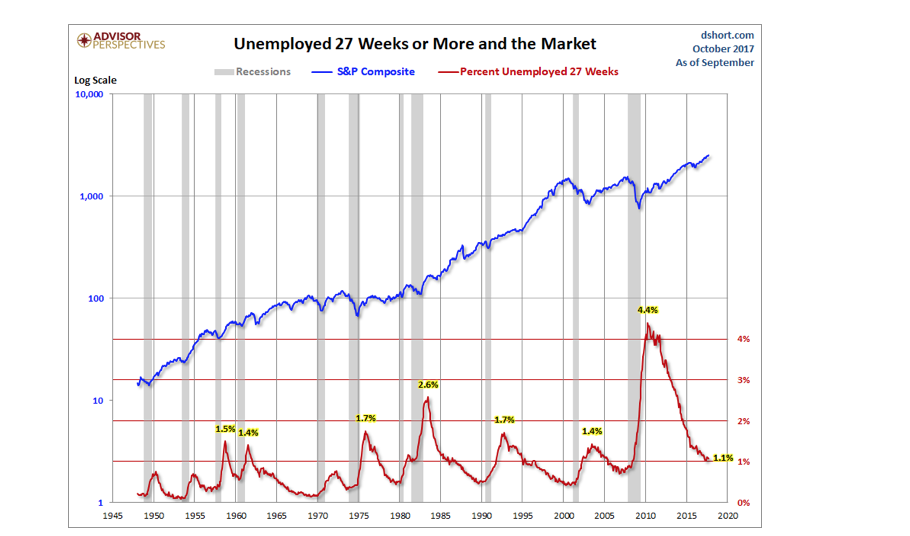
Robotization increasingly divides the country

To add more fuel to the fire, it should be recognized that in America, robotization has a positive effect on liberal suburbs, while conservative rural areas suffer from its consequences. According to the Daily Yonder analysis , 80% of the jobs created in 2016 were located in 51 suburbs, with a population of a million or more people. In just one year, in the suburbs, the number of jobs increased by 1.2 million . Meanwhile, in rural areas, at the same time, the number of jobs decreased by 90,000 .

Today, more than 52 million Americans live in economic districts . The report of the Economic Innovation Group (EIG), a research and advocacy organization supported by both parties, clearly shows a close relationship between the number of residents in the locality and their well-being. Thus, in districts with a population of less than 100,000 people, the probability of dissatisfaction with well-being is 11 times higher than in districts with a population of more than 100,000 people.
As soon as you realize that automation contributes to the division of the US population into “red” and “blue” lines, you will immediately understand the growing polarization of American politics. This is perhaps the most dangerous effect of technological unemployment , the erosion of democracy itself, since party engagement tears the nation apart, like the process of the mitotic division of a cell into two parts .

New, more productive enterprises
It must be admitted that since technologies allow enterprises to hire fewer workers, it is possible to achieve “full employment”, in which everyone can get a job. The laws of economics require that either everyone work on a shorter work week, or more people need more enterprises to employ the same number of employees. If the average number of employees of an average enterprise is 10 people, then 10 companies will be required to provide 100 people with jobs. If the technology allows 1 worker to perform work for 10 people, still working 40 hours a week, then the average number of workers will be reduced to 1. Therefore, the number of enterprises required for employment of 100 people should increase to 100 (note: given the population growth , the number of enterprises will exceed 100).
It happens? Not. This is not happening. The opposite happens. The number of newly created enterprises annually decreases, but does not increase.

But newly created enterprises increase their value every year. That is what we expect from each new enterprise using the latest technology to produce more and at lower cost.
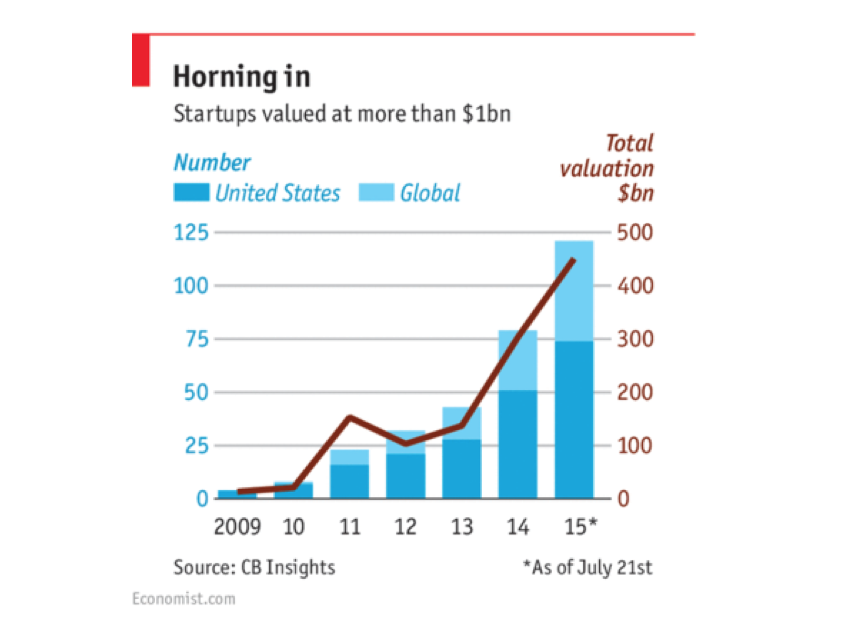
Every year there are more and more new businesses worth more than $ 1 billion. Compare Tesla with Ford Motors from the beginning of the 20th century, Instagram with Kodak, or Facebook with all pre-existing newspapers. These companies are worth hundreds of billions of dollars, and their staff is much less than the most expensive companies of the past.
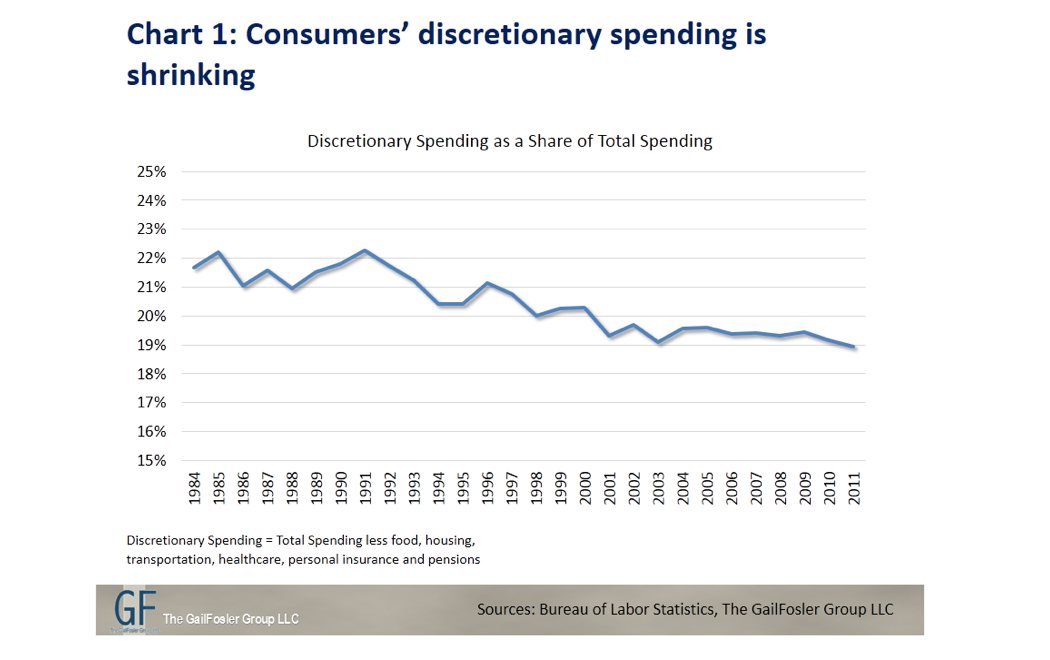
There is also an assumption about the infinity of human needs, so regardless of the number of jobs, reduced by the fault of technology, the unlimited consumer desires of a person will always contribute to the creation of new jobs. This belief coexists with a constant reduction in the proportion of unexpected expenses in total expenses . This should not surprise anyone. People can not spend money that is not.
The more you know ...
Now let me ask a question. Did you know everything I told you here, none of the above was news to you? Now ask yourself why? Robotization definitely exists and is already having an effect on the economy. So why are we still arguing about this? Perhaps the most frightening in the robotization graph of oil rigs, along with the other graphs that I included in this article, was the fact that the data presented are not discussed in society . It becomes like a climate change issue that we have been arguing about for decades, while the situation is only getting worse. Likewise, they prefer to reject the problem of robotization, although its influence is becoming increasingly significant.
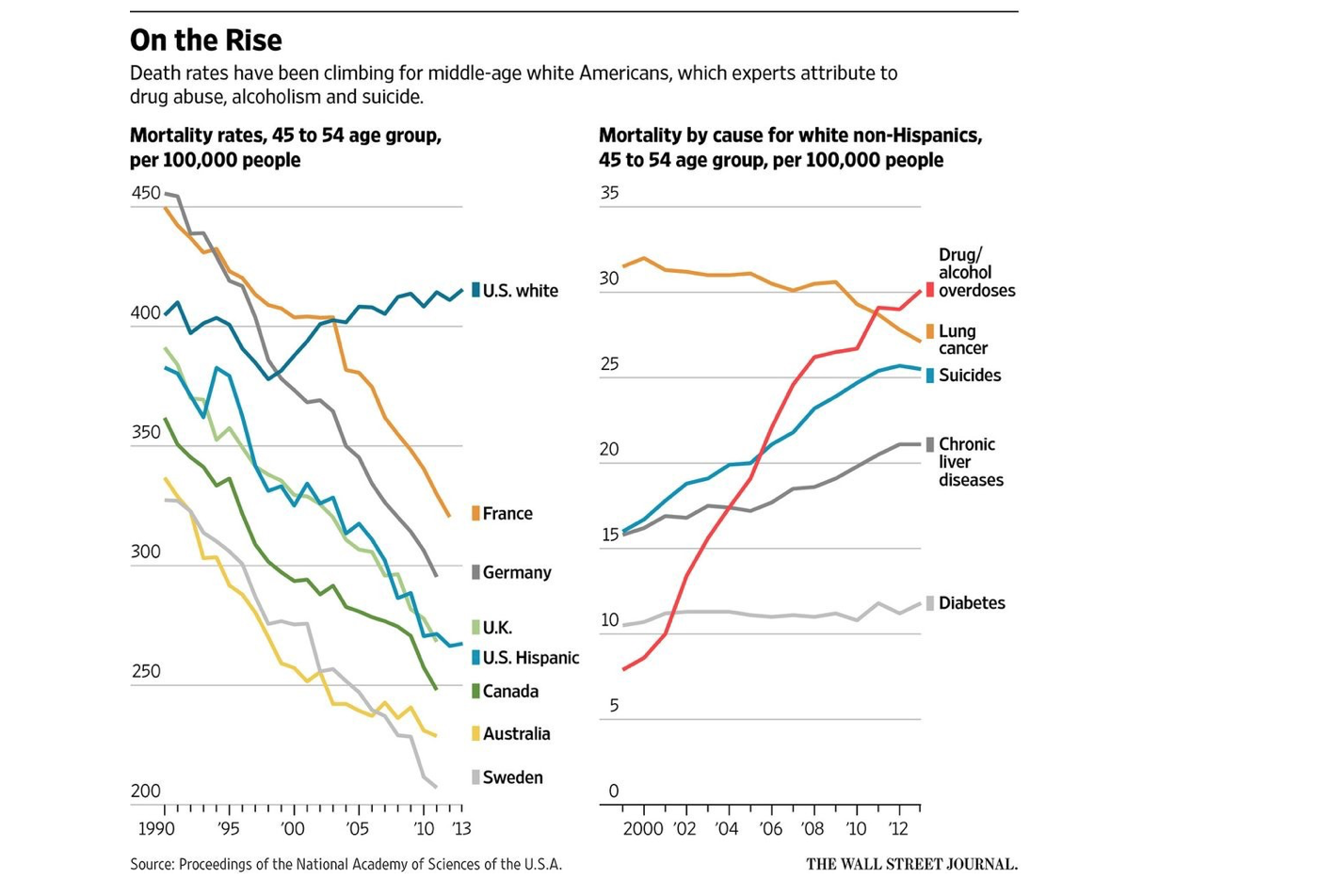
I am afraid that the problem will continue to be ignored. Why do I think so? We ignored the moment of production robotization. Yes, we know that it happened, but we pretended that all workers simply switched to a new paid job without critically assessing the nature of this work. Unemployment is not a problem, because the unemployment rate is at a record low? Tell about this to a person who has switched from a 40-hour work week with a social package and a sense of confidence in the future to three different jobs without a social package, where he works 80 hours a week, earning less and constantly fearing to lose even that.
Or tell about it to people who feel that marriage has become the prerogative of only rich people .
Or tell about it to people who tried to commit suicide or independently treated their depression with opiates , because the city-forming enterprise was closed in their city, destroying the local economy and leaving no means of livelihood.
Technological unemployment is real. In this situation, only one public discussion will be fair - what is the nature of the new employment? Everything speaks about reducing the share of employed among the economically active population , about the growth of low-skilled jobs , about switching to alternative labor relations (for example, temporary jobs and “part-time work”) , about increasing the variation in monthly income , about reducing benefits and compensations, about longer looking for a new job , and about what can be called a general uncertainty about tomorrow , because survival , not the “American dream”, becomes the main goal for most Americans.
At the same time, some Americans are doing well. Why? Because they own cars. They have lobbyists. They write the laws. They write the tax code. They have power. Now they are the only beneficiaries of machine labor, producing more and more national wealth, and once this wealth was distributed among a wider circle of people.
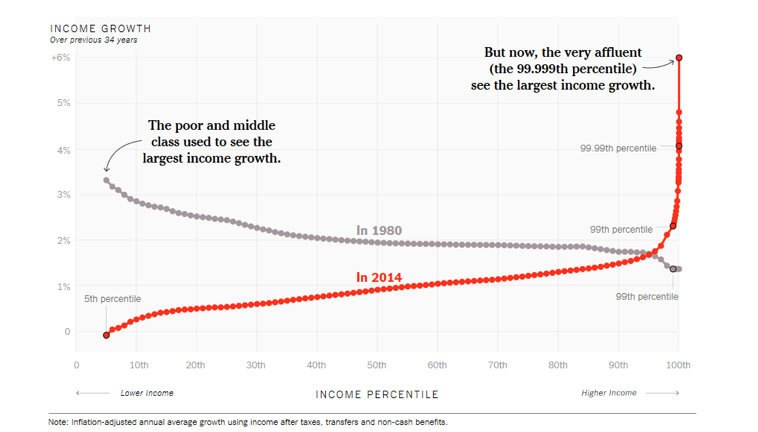
Hundreds of thousands of jobs were simply lost due to the automation of oil rigs, and no one (except those who lost their jobs and their families) did not even blink. Over the years, due to the use of industrial robots, hundreds of thousands of jobs have been reduced.
Hundreds of thousands of jobs have been cut this year in the retail industry due to Amazon’s unstoppable efficiency, which already employs more than 100,000 robots . In fairness, it is worth noting that Amazon also creates many new jobs, but for each newly created job there are two or more cutbacks, because the company removes the least efficient bricks or uncompetitive links. All talk about employment will be dishonest, unless we are talking about creating network jobs or the details of their creation.
The question is, at what point, quite a few people will realize that robotization is a very real problem that must be dealt with immediately. When are millions of jobs automated in road haulage ? Or when millions of retail jobs are being automated? How many people need to be cut before we have a collective desire to do something? And at what point we will understand that the problem of robotization should not be a problem at all , that we just want to automate the work as much as possible ? When will we understand that robotization is a blessing, not a curse? That the benefits of machine labor should extend to the whole society, and not focus in the hands of a relatively small group of people, especially considering that all technology originated from research and development funded by taxpayers and represents the technological heritage of our ancestors, who passed us their knowledge through generations . When the only beneficiaries of this heritage realize that, despite their interest in job cuts , do they still need customers?
Hope this time is coming soon. Very soon, because, looking at our reality, the question arises, is it too late to act, perhaps we are late? As long as we force each other to work for money in order to live, robotization will work against us.
The first priority of our civilization should be the rejection of the binding of income to work , which will create economic freedom for all. Without an unconditional basic income, the future is very bleak. With an unconditional basic income that grows as productivity increases, as a fair share of an increasingly robotic economy , the future will finally become a good place for humanity .
Source: https://habr.com/ru/post/342360/
All Articles